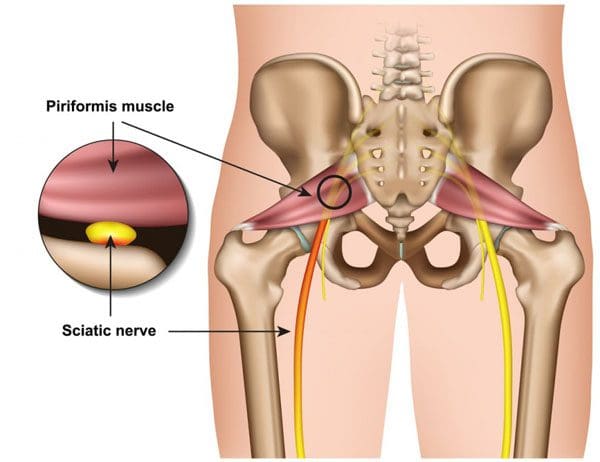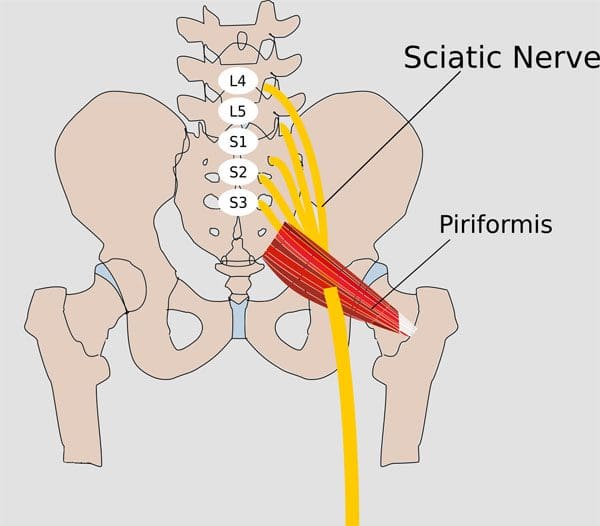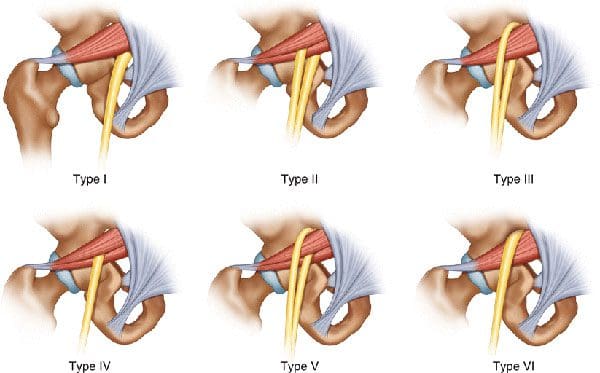Testing For Piriformis Syndrome or Sciatica through Chiropractic


Table of Contents
Symptoms
Piriformis syndrome does not always present the same way. Common symptoms include pain, tingling, and numbness in the buttocks that becomes worse when sitting. Other symptoms can include:- Pain when sitting, standing, or walking
- Pain when getting up from a seated/squatting position
- Pain in the sacroiliac joint
- Pain and/or pins and needles, burning, tingling, or itching sensation
- Movement helps to reduce pain symptoms
- Numbness in the foot
Causes
- Primary piriformis syndrome happens when there is a splitting of the piriformis muscle, the sciatic nerve, and/or the sciatic nerve does not run along the normal path.
- Secondary piriformis syndrome is more common and is caused by inflammation of the soft tissues, muscle spasms, or both. And the result is nerve compression.

- Direct trauma to the buttock area can definitely cause inflammation, scarring, and contraction of the piriformis muscle. This could be the result of an automobile accident, or a fall.
- The most common cause is a progressive tightening of the muscle brought on from a weakened piriformis muscle.
Testing
Because of the close relation between piriformis syndrome and sciatica, a chiropractic medical professional will perform various tests to determine if symptoms are spinal disc-related or caused by the sciatic nerve getting pinched, or impinged by the piriformis muscle. A chiropractor will examine the low back, hip, pelvis, sacroiliac joint, walking gait, posture, and leg length. They will test various body reflexes as well. Other tests can include:- Palpation/manipulation of the piriformis muscle
- A Straight leg raise will be done to see if there is localized pain when pressure is applied to the piriformis muscle and the tendon. The chiropractor will flex the hip at a 90-degree angle and extend/straighten the knee.
- A Freiberg test will be done to see if pain presents around the piriformis or reproduces symptoms.
- The Pace maneuver test looks for pain and/or weakness during rotation of the hip when sitting.
- The F.A.I.R test stands for flexion, adduction, and internal rotation. This test has the individual lie on the non-affected side while the chiropractor guides the painful leg into hip flexion, turns it in toward the body, and gently turns the lower leg outward.
- The Beatty maneuver tests for pain while lying on the non-affected side, and the chiropractor elevates the flexed symptomatic leg.
- Testing for pain or weakness in specific positions is conducted usually for one-minute or when the individual experiences symptoms.

Treatment for Sciatica
Dr. Alex Jimenez’s Blog Post Disclaimer
The scope of our information is limited to chiropractic, musculoskeletal, physical medicines, wellness, and sensitive health issues and/or functional medicine articles, topics, and discussions. We use functional health & wellness protocols to treat and support care for injuries or disorders of the musculoskeletal system. Our posts, topics, subjects, and insights cover clinical matters, issues, and topics that relate and support directly or indirectly our clinical scope of practice.* Our office has made a reasonable attempt to provide supportive citations and has identified the relevant research study or studies supporting our posts. We also make copies of supporting research studies available to the board and or the public upon request. We understand that we cover matters that require an additional explanation as to how it may assist in a particular care plan or treatment protocol; therefore, to further discuss the subject matter above, please feel free to ask Dr. Alex Jimenez or contact us at 915-850-0900. The provider(s) Licensed in Texas& New Mexico*References
The Journal of the Osteopathic Medical Association. (November 2008) “Diagnosis and Management of Piriformis Syndrome: An Osteopathic Approach ”jaoa.org/article.aspx?articleid=2093614Post Disclaimer
Professional Scope of Practice *
The information herein on "Testing For Piriformis Syndrome or Sciatica through Chiropractic" is not intended to replace a one-on-one relationship with a qualified health care professional or licensed physician and is not medical advice. We encourage you to make healthcare decisions based on your research and partnership with a qualified healthcare professional.
Blog Information & Scope Discussions
Welcome to El Paso's Wellness blog, where Dr. Alex Jimenez, DC, FNP-C, a board-certified Family Practice Nurse Practitioner (FNP-C) and Chiropractor (DC), presents insights on how our team is dedicated to holistic healing and personalized care. Our practice aligns with evidence-based treatment protocols inspired by integrative medicine principles, similar to those found on dralexjimenez.com, focusing on restoring health naturally for patients of all ages.
Our areas of chiropractic practice include Wellness & Nutrition, Chronic Pain, Personal Injury, Auto Accident Care, Work Injuries, Back Injury, Low Back Pain, Neck Pain, Migraine Headaches, Sports Injuries, Severe Sciatica, Scoliosis, Complex Herniated Discs, Fibromyalgia, Chronic Pain, Complex Injuries, Stress Management, Functional Medicine Treatments, and in-scope care protocols.
Our information scope is limited to chiropractic, musculoskeletal, physical medicine, wellness, contributing etiological viscerosomatic disturbances within clinical presentations, associated somato-visceral reflex clinical dynamics, subluxation complexes, sensitive health issues, and functional medicine articles, topics, and discussions.
We provide and present clinical collaboration with specialists from various disciplines. Each specialist is governed by their professional scope of practice and their jurisdiction of licensure. We use functional health & wellness protocols to treat and support care for the injuries or disorders of the musculoskeletal system.
Our videos, posts, topics, subjects, and insights cover clinical matters, issues, and topics that relate to and directly or indirectly support our clinical scope of practice.*
Our office has reasonably attempted to provide supportive citations and has identified the relevant research studies or studies supporting our posts. We provide copies of supporting research studies available to regulatory boards and the public upon request.
We understand that we cover matters that require an additional explanation of how they may assist in a particular care plan or treatment protocol; therefore, to discuss the subject matter above further, please feel free to ask Dr. Alex Jimenez, DC, APRN, FNP-BC, or contact us at 915-850-0900.
We are here to help you and your family.
Blessings
Dr. Alex Jimenez DC, MSACP, APRN, FNP-BC*, CCST, IFMCP, CFMP, ATN
email: coach@elpasofunctionalmedicine.com
Licensed as a Doctor of Chiropractic (DC) in Texas & New Mexico*
Texas DC License # TX5807
New Mexico DC License # NM-DC2182
Licensed as a Registered Nurse (RN*) in Texas & Multistate
Texas RN License # 1191402
ANCC FNP-BC: Board Certified Nurse Practitioner*
Compact Status: Multi-State License: Authorized to Practice in 40 States*
Graduate with Honors: ICHS: MSN-FNP (Family Nurse Practitioner Program)
Degree Granted. Master's in Family Practice MSN Diploma (Cum Laude)
Dr. Alex Jimenez, DC, APRN, FNP-BC*, CFMP, IFMCP, ATN, CCST
My Digital Business Card


